Oily skin and hyperseborrhea: models and assays
in vitro models & assays
QIMA Life Sciences has many in vitro or ex vivo models at your disposal:
- sebocyte cell line (SEBO662)
- 3D sebocyte cell line (SEBO662 3D)
- sebocyte cell line in response to androgens (SEBO662AR)
on which we can evaluate the effects of active ingredients or cosmetic formulations on sebaceous gland regulation and acne by measuring:
- sebocyte differentiation and maturation (EMA, KRT7, etc.)
- lipidogenesis (lipid accumulation and production)
- 5-alpha reductase activity and testosterone metabolism
Here are a few examples among all assays proposed by QIMA Life Sciences in the field of oily skin and hyperseborrhea:
No products found which match your selection.
Biochemical analysis of non-invasive clinical samples
Analysis of sebum components and free fatty acids
Our company has developed ready-to-use non-invasive collection kits to analyze the surface lipids and biomarkers of the skin from your samples, or from those of your clinical center.
The sebaceous lipids and the fatty acids that constitute the epidermis and scalp are sampled using two non-invasive sampling kits (SB Kit and SW Kit).
The analysis of the components of sebum and free fatty acids makes it possible to assess:
- The lipase activity of certain microorganisms in the skin microbiota
- Sebum regulation
- Inflammation – by quantification of pro / anti-inflammatory fatty acids
- Oxidative stress – peroxidation (peroxidized squalene), detoxification (CAT, SOD)
- Anti-microbial activity
- The qualitative and quantitative composition of sebum
These analyses help support your claims about the efficacy of anti-acne, oily skin, soothing, protective, anti-pollution products, etc.
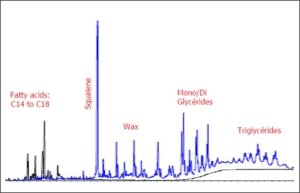
Sebaceous lipids screening
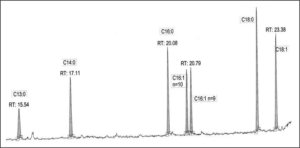
Detailed composition of sebum fatty acids by CG/SM
Skin microbiota and inflammation analysis
Hyperseborrhea is frequently associated with disorders of the skin microbiota. Maintaining a good balance in the microbiota helps minimize the inflammation caused by the bacteria that colonize the hair follicle (e.g. C. acnes).
Samples are taken using the SW Kit. The qualitative and quantitative analyses of the bacteria present on the surface of the skin are carried out by:
- Traditional microbiology on agar
- Targeted qPCR
- Non-targeted metagenomic analysis
Inflammatory markers (cytokines, fatty acids, PGE2) are also analyzed.
These analyses help support your claims about the efficacy of “friendly” microbiota, bacteriostatic, prebiotic, soothing products, etc.
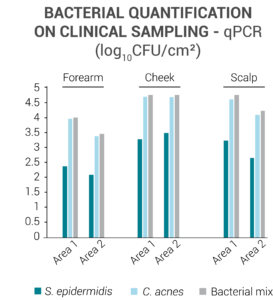
Data mapping and clinical imaging
Oily and acne-prone skin presents many markers that can be monitored by 2D color imaging.
Measurement of skin imperfections and of oily skin inflammation in 2D color imaging
Acne lesions can be detected by image analysis, by using powerful algorithms that can discriminate inflammatory lesions from non-inflammatory lesions, or post-inflammatory pigmentation.
The monitoring of inflammation parameters allows the effectiveness of acne skincare products to be measured, either on the whole face or locally by macro imaging, and for short-range or long-range kinetics.
The density of lesions, their total surface and their color are all markers of their evolution.
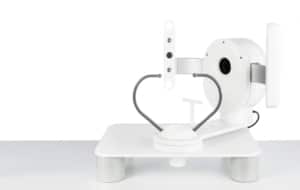
ColorFace®
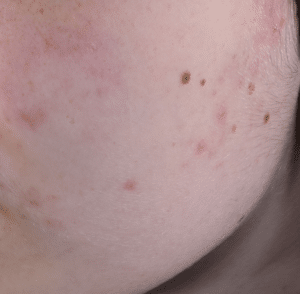
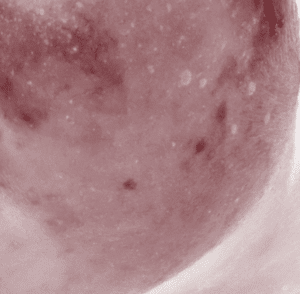
Acquisition and analysis of acneic lesions and of inflammation on images acquired with ColorFace®
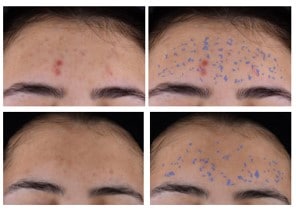
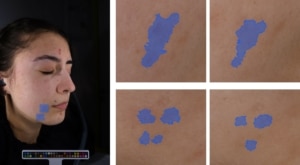
Analysis of PIH of whole face on images acquired with ColorFace®
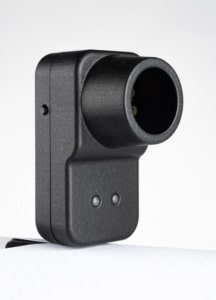
SkinCam
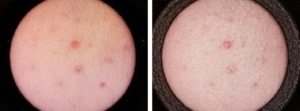
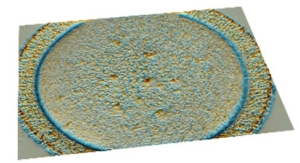
Analysis and monitoring of lesions on images acquired with SkinCam®
Measurement of acne lesions and inflammation by hyperspectral imaging
Newtone’s hyperspectral imaging is a unique technology developed to calculate the skin chromophore absorption mappings, and consequently to measure evolution over time, while providing a perfectly representative image of the measured evolution.
Acquisition systems allow image acquisition of the whole face (SpectraFace) or of a defined area of the body and face (SpectraCam).
On these images, hemoglobin can be monitored and analyzed as by color imaging, while discriminating it from melanin. On these images, the same parameters as in 2D color imaging can be extracted for each skin lesion, in addition to hemoglobin concentration.
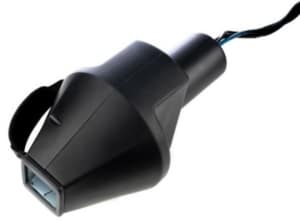
Spectracam
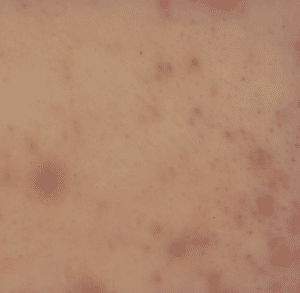
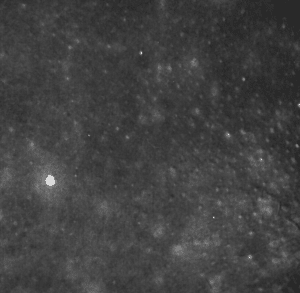
Acquisition and analysis of acneic lesions and inflammation on images acquired with SpectraCam®
Measurement of oily skin gloss linked to seborrhea in 2D color imaging
Oily skin gloss is measured by calculating the quantity of specular reflection. A gloss map extraction and the monitoring of oily skin glossiness allow sebum evolution to be monitored and anti-seborrheic and mattifying effects to be evaluated.
The monitoring of glossiness parameters allows the effectiveness of oily skin care products to be measured, either on the whole face or locally by macro imaging, and for short-range or long-range kinetics.

ColorFace®
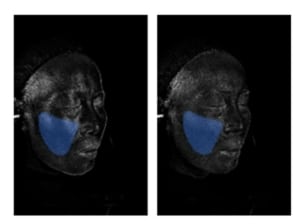 Measurement of gloss map of cheek on image acquired with ColorFace®
Measurement of gloss map of cheek on image acquired with ColorFace®
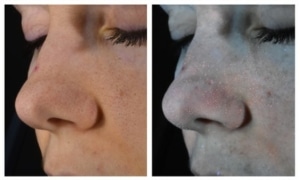
Measurement of skin fluorescence on image acquired with ColorFace ®
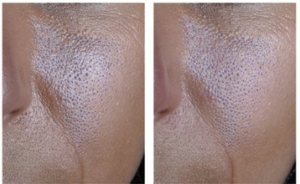
Measurement of pore visibility on image acquired with ColorFace®
Measurement of porphyrin fluorescence in UV imaging
Acne-prone skin can present a high fluorescence rate under UV, due to the metabolism of the bacteria specific to acne. The measurement of porphyrin fluorescence intensity is therefore a marker of the evolution of the inflammatory and bacterial skin condition.
Measurement of pore visibility in 2D imaging
One of the characteristics of oily skin is an increased pore visibility, which is linked to pore dilation and obstruction, as well as to the glossiness induced by seborrhea.
Pore analysis can be carried out on images in parallel and cross polarized light, according to the required method.
Parameters for surface, for detected pore density and for visible depth are all markers to be monitored in order to investigate the astringent effect of the treatment.






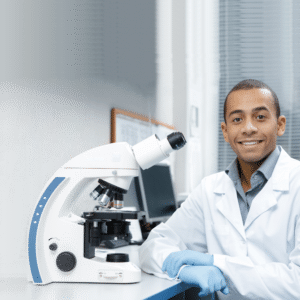
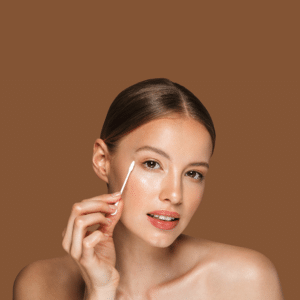


Innate immunity activation of sebocyte cells by living bacteria. Evidence of a potential immunosuppressive effect of DHT.
Acne, Microbiome cutané, Sebaceous gland regulation, Skin microbiome, Skin microbiomeAcne is a skin pathology targeting the pilosebaceous unit…sebum hypersecretion and bacterial infection. We studied the effects of living bacteria on the induction of an innate immune response in a sebocyte cell line.
Pharmacological effects of anti-androgens and other compounds in an androgen-sensitive sebocyte cell line.
Acne, Sebaceous gland regulationWe analysed the activity of reference anti-androgens (Finasteride, Dutasteride, Cyproterone acetate), at the level of their potential targets (5-alpha-reductase, AR translocation, induced transcripts) and in a functional lipid accumulation assay. We also evaluated this androgen-induced lipid accumulation assay as a potential pharmacological tool to detect potential inhibitors from both androgenic and non-androgenic origins.
Androgens activate lipogenesis through an AKT-independent mTOR pathway stimulation and a limitation of autophagy in an androgen-sensitive sebocyte cell line.
Acne, Peau grasse, hyperséborrhée et séborégulation, Sebaceous gland regulationAndrogens are key regulators of sebaceous function… A link between mTOR and androgen signaling has previously been reported…as well as a link between these processes and lipid synthesis…Here we aimed at confirming that DHT-induced lipid synthesis/accumulation is at least in part dependent on mTOR activation in the SEBO662AR cell line and that the autophagic process is consequently modified by the androgenic treatment.
Effects of different kinds of pollutants on the lipidic metabolism of human sebocytes and protective effects of a new macroalgae culture extract
Cosmetics_cat_publi, Peau grasse, hyperséborrhée et séborégulation, Sebaceous gland regulation, Skin protection and immune defense systemSebocytes lipid production are stimulated by pollutants. Ame acts by protecting epidermal cells, human sebocytes and skin from urban dust.
Acne vulgaris: physiopathology and cell mechanisms
Acne, Sebaceous gland regulationAcne Vulgaris is a chronic inflammatory pathology located in the region of the pilosebaceous follicle. It occurs following a high production of sebum linked to hormonal (androgynous) or environmental (pollution) malfunctioning and to the colonization of the pilosebaceous follicle by certain bacteria (P. acnes).
QIMA Life Sciences has developed a panel of innovative assays to discover and evaluate compounds for the treatment of acne.
Physiology and functions of the sebaceous gland
Acne, Sebaceous gland regulation, Skin barrier and hydrationThe sebaceous gland is an organ located in the dermis. Its role is to synthesise and secrete sebum which is a component of the hydrolipidic film. The purpose of sebum is to protect the skin from external aggression and dehydration. Sebum also maintains the suppleness of the skin and hair.